空气压缩机使用说明书1
- 格式:doc
- 大小:68.00 KB
- 文档页数:19
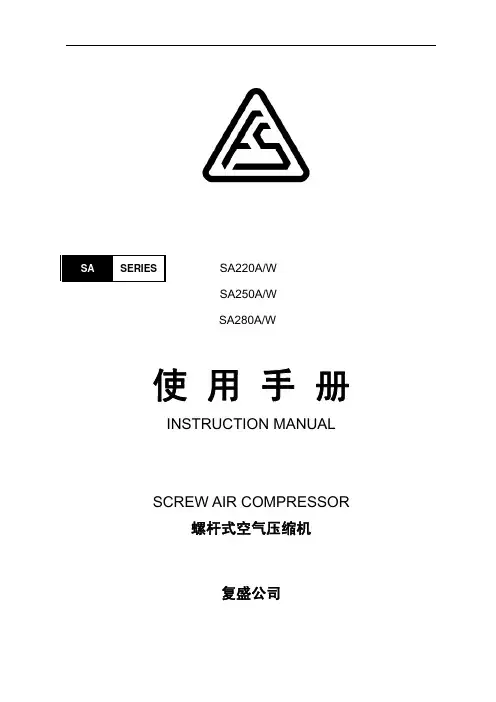
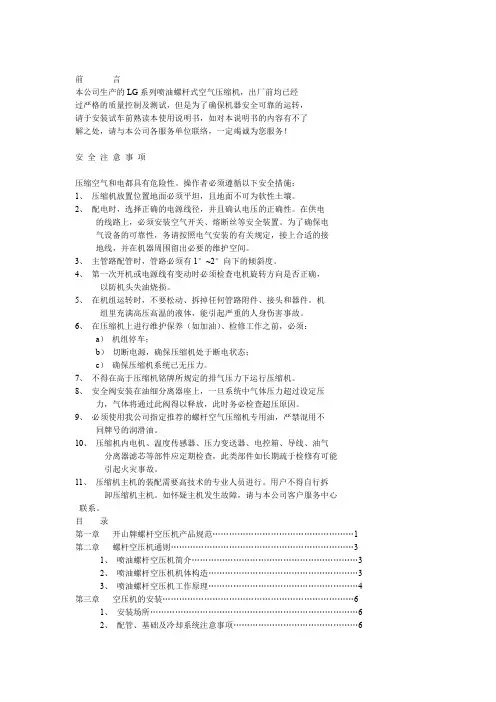
前言本公司生产的LG系列喷油螺杆式空气压缩机,出厂前均已经过严格的质量控制及测试,但是为了确保机器安全可靠的运转,请于安装试车前熟读本使用说明书,如对本说明书的内容有不了解之处,请与本公司各服务单位联络,一定竭诚为您服务!安全注意事项压缩空气和电都具有危险性。
操作者必须遵循以下安全措施:1、压缩机放置位置地面必须平坦,且地面不可为软性土壤。
2、配电时,选择正确的电源线径,并且确认电压的正确性。
在供电的线路上,必须安装空气开关、熔断丝等安全装置。
为了确保电气设备的可靠性,务请按照电气安装的有关规定,接上合适的接地线,并在机器周围留出必要的维护空间。
3、主管路配管时,管路必须有1°~2°向下的倾斜度。
4、第一次开机或电源线有变动时必须检查电机旋转方向是否正确,以防机头失油烧损。
5、在机组运转时,不要松动、拆掉任何管路附件、接头和器件。
机组里充满高压高温的液体,能引起严重的人身伤害事故。
6、在压缩机上进行维护保养(如加油)、检修工作之前,必须:a)机组停车;b)切断电源,确保压缩机处于断电状态;c)确保压缩机系统已无压力。
7、不得在高于压缩机铭牌所规定的排气压力下运行压缩机。
8、安全阀安装在油细分离器座上,一旦系统中气体压力超过设定压力,气体将通过此阀得以释放,此时务必检查超压原因。
9、必须使用我公司指定推荐的螺杆空气压缩机专用油,严禁混用不同牌号的润滑油。
10、压缩机内电机、温度传感器、压力变送器、电控箱、导线、油气分离器滤芯等部件应定期检查,此类部件如长期疏于检修有可能引起火灾事故。
11、压缩机主机的装配需要高技术的专业人员进行。
用户不得自行拆卸压缩机主机。
如怀疑主机发生故障,请与本公司客户服务中心联系。
目录第一章开山牌螺杆空压机产品规范 (1)第二章螺杆空压机通则 (3)1、喷油螺杆空压机简介 (3)2、喷油螺杆空压机机体构造 (3)3、喷油螺杆空压机工作原理 (4)第三章空压机的安装 (6)1、安装场所 (6)2、配管、基础及冷却系统注意事项 (6)3、电器一般规范及安全规范 (7)第四章系统流程及各零部件功能 (8)1、系统流程图 (8)2、系统流程 (9)1) 空气流程 (9)2)润滑油流程 (10)3、气路控制系统 (12)4、微电脑控制器 (14)第五章操作 (29)1、试车 (29)2、日常操作 (29)3、长期停机的处理方式 (30)第六章保养与检查 (31)1、润滑油的规范及使用保养 (31)2、空气滤清器的维护保养 (32)3、油过滤器的更换 (32)4、油细分离器的更换 (32)5、保养周期及内容 (33)第七章日常保养及故障排除 (34)1、故障排除表 (34)36、开山牌螺杆空压机运转记录表 (2)第一章开山牌螺杆空压机产品规范型号排气压力排气量电机功率排气重量外形尺寸mmkgModel MPa m/min kW接口31.2 0.8 LG-1.2/89001.0 LG-1.0/10 ×7007.51.0 400×1040G10.8 1.3 LG-0.8/131.7 0.7 LG-1.7/71.7 0.8 LG-1.7/8 G1 500 1060×800×123011 1.5 LG-1.5/10 1.01.2 LG-1.2/13 1.32.4 LG-2.4/7 0.72.4 LG-2.4/8 0.8 G1 550 1060×800×15 1230 2.2 1.0 LG-2.2/101.7 LG-1.7/13 1.31420×850×LG-3/8G 0.8 3 11103 LG-3/7 0.7G1LG-3/8 0.8 65018.5 3 1080×880×14152.7 1.0 LG-2.7/102.3 1.3 LG-2.3/1314200.8 ×3.6 850LG-3.6/8G ×11103.6 LG-3.6/7 0.7G122 LG-3.6/8 3.6 0.8 7001080×880×14153.2 LG-3.2/10 1.02.7 1.3 LG-2.7/135.2 LG-5.2/7 0.75 LG-5/8 0.8 G11/2 1000 1300×110030 ×1650 4.5 1.0 LG-4.5/103.7 1.3 LG-3.7/131600×0.7 970×6.5 LG-6.5/7G 12056.5 LG-6.5/7 0.7G11/26.2 LG-6.2/8 10500.8 37 1300×1100×16505.6 LG-5.6/10 1.04.8 LG-4.8/13 1.31778×7.4 1000LG-7.4/7G ×0.7 13007.4 LG-7.4/7 0.7G11/20.8 1150LG-7.1/8 7.1 45 1300×1100×16506.5 LG-6.5/10 1.05.6LG-5.6/131.310.5LG-10.5/70.71821161550100.8LG-10/8G11/25516008.71.0LG-8.7/1016212316707.5LG-7.5/131.3型号排气压力排气量电机功率排气重量外形尺寸mmkW Model接口MPa m/minkg 313 LGH-13/7 0.712 LGH-12/8 0.810 LGH-10/10 1.0 2440×1160×1620208013 0.8 LG-13/8 G2 7512 LG-12/10 1.010 1.0 LG-10/1015801.3 ×10 1320×1646LG-10/1316 LGH-16/7 0.716.5 LG-16.5/7 0.790 16 LG-16/8 G2 2150 2560×1300×16200.814 LG-14/10 1.012 LG-12/13 1.321 LGH-21/7 0.720 LG-20/7 0.7110 20 DN65 3900 27600.8 ×1340×LG-20/8 171016 1.0 LG-16/1013 LG-13/13 1.324 LG-24/8 0.822 LG-22/8 0.8 132 DN65 4000 2760×1340×171020 LG-20/10 1.016 LG-16/13 1.328 0.7 LG-28/727 LG-27/8 0.8 160 DN65 4200 2860×1510×181025 LG-25/10 1.020 1.3 LG-20/1330 0.8 LG-30/8 185 DN65 4300 2860×1510×181021 LG-21/13 1.335 LG-35/8 0.8200 DN80 4500 1.0 30 LG-30/10 3250×1821×200027 LG-27/13 1.344 LG-44/8 0.8250 LG-38/10 38 DN100 4800 37001.0 ×2221×205033LG-33/131.3注:☆字母G表示齿轮直联传动。
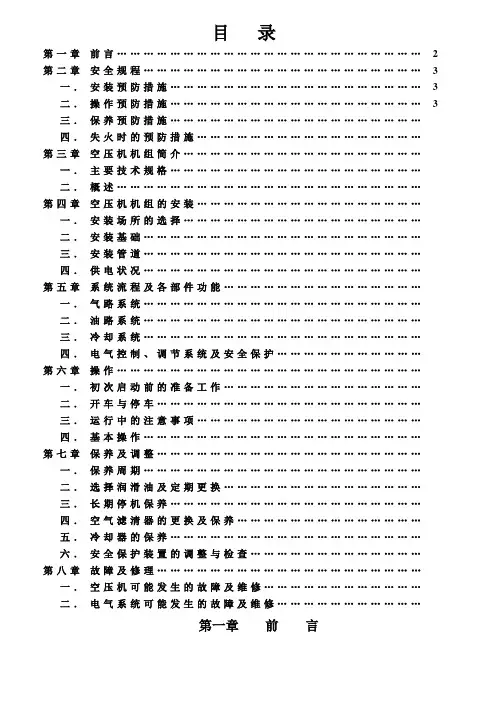
目录第一章前言 (2)第二章安全规程 (3)一.安装预防措施 (3)二.操作预防措施 (3)三.保养预防措施…………………………………………………四.失火时的预防措施……………………………………………第三章空压机机组简介………………………………………………一.主要技术规格…………………………………………………二.概述……………………………………………………………第四章空压机机组的安装……………………………………………一.安装场所的选择………………………………………………二.安装基础………………………………………………………三.安装管道………………………………………………………四.供电状况………………………………………………………第五章系统流程及各部件功能………………………………………一.气路系统………………………………………………………二.油路系统………………………………………………………三.冷却系统………………………………………………………四.电气控制、调节系统及安全保护……………………………第六章操作……………………………………………………………一.初次启动前的准备工作………………………………………二.开车与停车……………………………………………………三.运行中的注意事项……………………………………………四.基本操作………………………………………………………第七章保养及调整……………………………………………………一.保养周期………………………………………………………二.选择润滑油及定期更换………………………………………三.长期停机保养…………………………………………………四.空气滤清器的更换及保养……………………………………五.冷却器的保养…………………………………………………六.安全保护装置的调整与检查…………………………………第八章故障及修理……………………………………………………一.空压机可能发生的故障及维修………………………………二.电气系统可能发生的故障及维修……………………………第一章前言尊敬的用户,非常感谢您选用神龙牌螺杆式空气压缩机,S L O G系列产品是依据最新技术标准设计制造,具有操作简单、运行稳定可靠、效率高、维护方便等优点和特性。
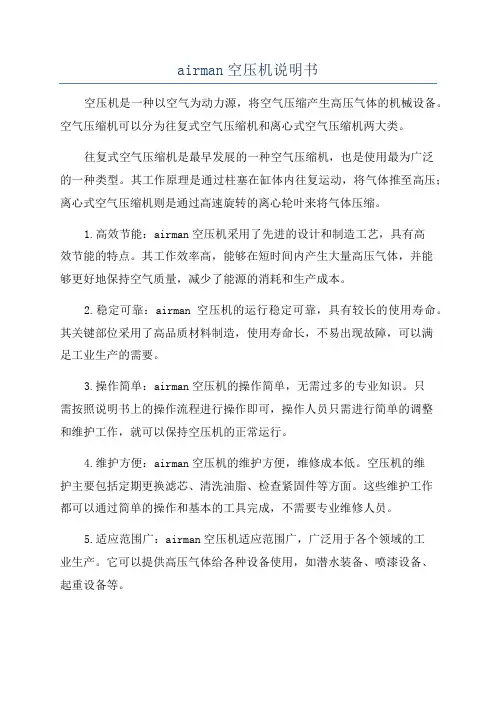
airman空压机说明书空压机是一种以空气为动力源,将空气压缩产生高压气体的机械设备。
空气压缩机可以分为往复式空气压缩机和离心式空气压缩机两大类。
往复式空气压缩机是最早发展的一种空气压缩机,也是使用最为广泛的一种类型。
其工作原理是通过柱塞在缸体内往复运动,将气体推至高压;离心式空气压缩机则是通过高速旋转的离心轮叶来将气体压缩。
1.高效节能:airman空压机采用了先进的设计和制造工艺,具有高效节能的特点。
其工作效率高,能够在短时间内产生大量高压气体,并能够更好地保持空气质量,减少了能源的消耗和生产成本。
2.稳定可靠:airman空压机的运行稳定可靠,具有较长的使用寿命。
其关键部位采用了高品质材料制造,使用寿命长,不易出现故障,可以满足工业生产的需要。
3.操作简单:airman空压机的操作简单,无需过多的专业知识。
只需按照说明书上的操作流程进行操作即可,操作人员只需进行简单的调整和维护工作,就可以保持空压机的正常运行。
4.维护方便:airman空压机的维护方便,维修成本低。
空压机的维护主要包括定期更换滤芯、清洗油脂、检查紧固件等方面。
这些维护工作都可以通过简单的操作和基本的工具完成,不需要专业维修人员。
5.适应范围广:airman空压机适应范围广,广泛用于各个领域的工业生产。
它可以提供高压气体给各种设备使用,如潜水装备、喷漆设备、起重设备等。
空压机是现代工业生产中必不可少的一种设备,它可以将空气压缩增压,为各种需要高压气体的设备提供动力。
airman空压机作为一种往复式空气压缩机,具有高效节能、稳定可靠、操作简单、维护方便和适应范围广等优势。
无论是在工业生产中还是在家庭使用中,airman空压机都能够发挥重要的作用。
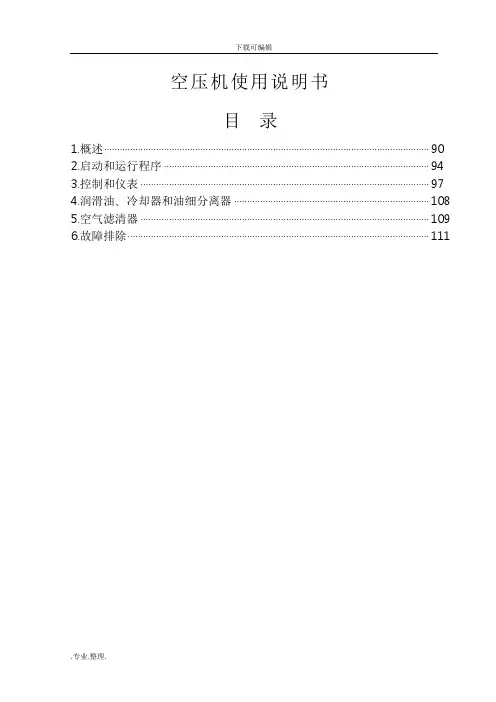
下载可编辑空压机使用说明书目录1.概述 (90)2.启动和运行程序 (94)3.控制和仪表 (97)4.润滑油、冷却器和油细分离器 (108)5.空气滤清器 (109)6.故障排除 (111)1.概述压缩机:原装进口的螺杆压缩机主机是一靠啮合的螺旋形转子进行压缩的单级容积式回转机械。
两转子都靠安装在压缩腔外的高额定负载转子轴承支承,单一宽度的圆柱滚子轴承装在吸气端承受径向载荷。
装在排气端的圆锥滚子轴承对转子进行轴向定位并承受所有轴向载荷和剩余的径向载荷。
压缩原理(图1-1):压缩是通过主辅转子在一气缸内同时啮合来完成的。
主转子有四个互成90°分布的螺旋形凸齿,辅转子有五个互成60°分布的螺旋形凹槽与主转子凸齿啮合。
空气入口位于压缩机气缸顶部靠近驱动轴侧。
排气口在气缸底部相反的一侧。
图1—1是为了表示吸、排气口的反向视图,当转子在吸气口尚未啮合时,空气流入主转子凸齿和辅转子凹槽的空腔内,此时压缩循环开始。
(见图A)当转子与吸气口脱开时,空气被封闭在主辅转子构成的空腔内,并随啮合的转子轴向移动,(见图B)当继续啮合,更多的主转子凸齿进入辅转子的凹槽,容积减少,压力升高。
喷入气缸的油用以带走压缩产生的热量和密封内部间隙。
容积减少,压力升高一直持续到封闭在转子内腔中的油气混和物通过排气孔口排入油气桶内的时候。
为了生成一个连续平稳无冲击的压缩空气流,转子上的每一容积都以极高的连续性遵循同样的“吸气——压缩——排气”循环。
压缩机系统的空气流程(图4—1):空气进入空气滤清器,流经吸气卸荷阀进入压缩机,经压缩后,油气混合物进入油气桶内,在那里,大多数带走的油通过速度变化和撞击从空气中分离出来,并落入油气桶内。
空气和残留的油进入分离器,在那里油被分离并通过分离器壳体与压缩机之间的连接管道流回压缩机。
空气流经压力维持阀,排气止回阀和冷却器,然后进入车间空气管线。
润滑、冷却和密封:油气桶内的空气压力驱使润滑油流过油冷、热控阀和油过滤器,排入压缩机主油路。
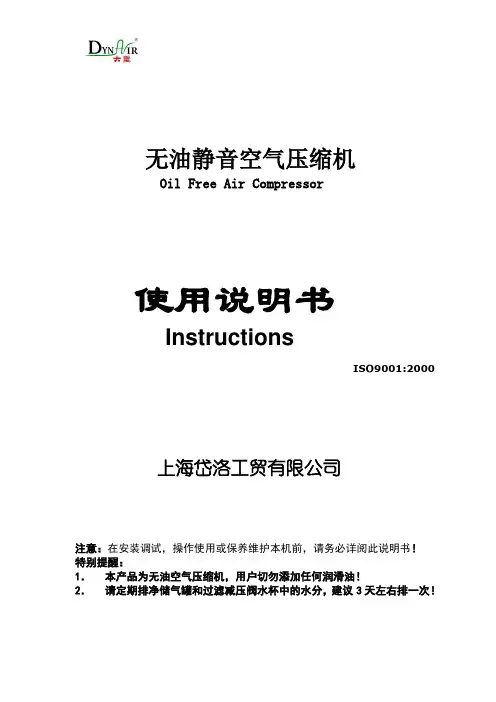
无油静音空气压缩机Oil Free Air Compressor使用说明书InstructionsISO9001:2000上海岱洛工贸有限公司注意:在安装调试,操作使用或保养维护本机前,请务必详阅此说明书!特别提醒:1.本产品为无油空气压缩机,用户切勿添加任何润滑油!2.请定期排净储气罐和过滤减压阀水杯中的水分,建议3天左右排一次!非常感谢您选择使用本公司生产的DYNAIR大圣牌无油低噪音空压机!它是本公司采用美国先进压缩机技术精心研制的多用途节能型机电一体化产品。
真正具有噪音低,体积小,造型美观,耗电省,维护简单以及安全耐用等优点。
可广泛使用于医疗器械,分析仪器,教学科研,国防,环保,轻工,食品加工,制药机械,日常生活等领域,是各种器械配套的理想气源,是性能优良的进口替代产品。
一、安全须知以下所列出的是使用大圣牌医用无油空气压缩机时需遵守的的安全注意事项。
使用前请仔细通读,阅读后妥善保存。
使用时必须绝对遵守安全事项,以防火灾、触电、人身伤害及其它事故。
1、保持工作场所清洁:杂乱无章容易导致事故发生。
2、注意工作场所环境:空压机不可任其风吹雨打,勿在潮湿和阴暗的地方工作,勿在存放易燃易爆液体气体和多灰尘的地方工作。
3、谨防触电:在使用空压机时,请不要让身体触及接地物品(如导管、暖气管、电冰箱等)。
4、外人/孩童勿近:不让孩童与作业无关的人员靠近空压机,以孩伤害、触电。
5、妥善保管机器:不使用的空压机,应放掉储气罐内的空气与污水,存放于干燥的环境中。
6、勿强迫使用机器:按照空压机上的标定的电压、速率或负载操作,效果会更佳更安全。
(连续运转时间不超过一小时,否则会影响使用寿命)7、保护电缆:不得扯拉电缆从电源拔出插头,电缆应远离热源和油液,并避免与锐利的物体接触。
8、妥善保养机器:应根据使用情况及时清洗滤清器,定期检查附件、电缆线,损坏立即更换。
应保持机器清洁干爽不沾油污,这样才能充分发挥性能。
9、及时切断电源:下班不使用时,养成及时切断电源的习惯。
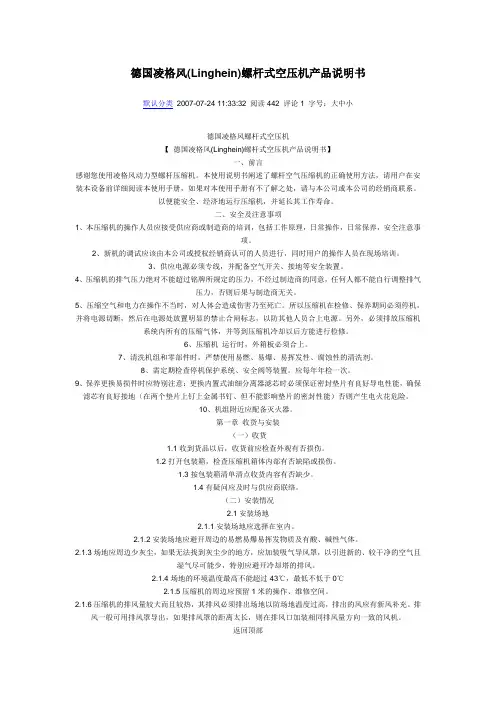
德国凌格风(Linghein)螺杆式空压机产品说明书默认分类2007-07-24 11:33:32 阅读442 评论1 字号:大中小德国凌格风螺杆式空压机【德国凌格风(Linghein)螺杆式空压机产品说明书】一、前言感谢您使用凌格风动力型螺杆压缩机。
本使用说明书阐述了螺杆空气压缩机的正确使用方法,请用户在安装本设备前详细阅读本使用手册,如果对本使用手册有不了解之处,请与本公司或本公司的经销商联系。
以便能安全、经济地运行压缩机,并延长其工作寿命。
二、安全及注意事项1、本压缩机的操作人员应接受供应商或制造商的培训,包括工作原理,日常操作,日常保养,安全注意事项。
2、新机的调试应该由本公司或授权经销商认可的人员进行,同时用户的操作人员在现场培训。
3、供应电源必须专线,并配备空气开关、接地等安全装置。
4、压缩机的排气压力绝对不能超过铭牌所规定的压力,不经过制造商的同意,任何人都不能自行调整排气压力,否则后果与制造商无关。
5、压缩空气和电力在操作不当时,对人体会造成伤害乃至死亡。
所以压缩机在检修、保养期间必须停机,并将电源切断,然后在电源处放置明显的禁止合闸标志,以防其他人员合上电源。
另外,必须排放压缩机系统内所有的压缩气体,并等到压缩机冷却以后方能进行检修。
6、压缩机运行时,外箱板必须合上。
7、清洗机组和零部件时,严禁使用易燃、易爆、易挥发性、腐蚀性的清洗剂。
8、需定期检查停机保护系统、安全阀等装置。
应每年年检一次。
9、保养更换易损件时应特别注意:更换内置式油细分离器滤芯时必须保证密封垫片有良好导电性能,确保滤芯有良好接地(在两个垫片上钉上金属书钉、但不能影响垫片的密封性能)否则产生电火花危险。
10、机组附近应配备灭火器。
第一章收货与安装(一)收货1.1收到货品以后,收货前应检查外观有否损伤。
1.2打开包装箱,检查压缩机箱体内部有否缺陷或损伤。
1.3按包装箱清单清点收货内容有否缺少。
1.4有疑问应及时与供应商联络。
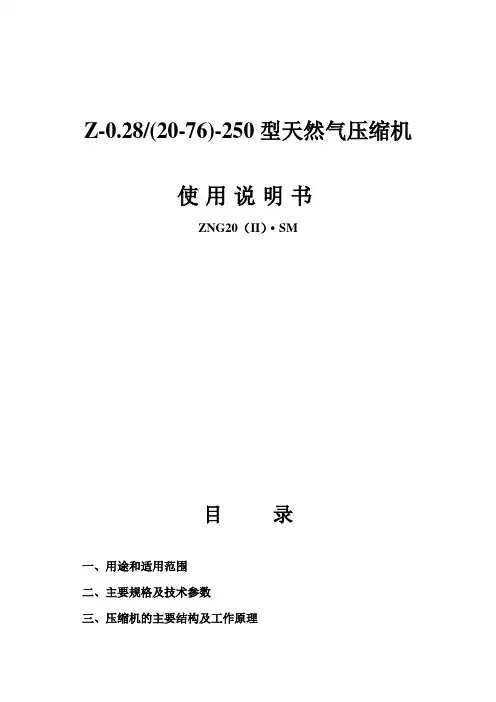
Z-0.28/(20-76)-250型天然气压缩机使用说明书ZNG20(II)·SM目录一、用途和适用范围二、主要规格及技术参数三、压缩机的主要结构及工作原理四、压缩机的安装五、压缩机的装配及拆卸注意事项六、压缩机的操作与使用七、压缩机的油封和保管八、运行故障与排除方法九、主要配合件装配间隙十、保证十一、产品成套设备、随机工具、备品备件、文件清单十二、随机安装图样一、用途和适用范围Z-0.28/(20-76)-250型天然气压缩机(以下简称压缩机),是将气体压力为2-20MPa 的净化天然气(经母站压缩机压缩,净化的天然气)压缩到25MPa,供气量为300-1350Nm3/h(吸气压力为2.0~7.6MPa时),输入车载气瓶内作为燃料代替汽油使用的主要设备。
该压缩机对天然气气质的要求:不含游离水,硫化氢(HS)含量<15mg/Nm3,低热2值≥31.4Mj/N m3,含尘量≤5mg/N m3,总硫含量(以硫计)≤100mg/N m3。
二、主要规格及技术参数(一)、压缩机1、型号:Z-0.28/(20-76)-2502、型式:Z型两级混冷活塞式3、压缩介质:净化天然气4、进气压力:2.0~20MPa5、压缩机启动压力:2.0~17MPa6、进气温度:≤30℃7、排气压力:25MPa8、排气温度:≤160℃(冷却前);≤环境温差+15℃(冷却后)9、排气量:0.28M3/min10、供气量:300~1350Nm3/h11、含油量:≤5ppm12、噪声:≤75dB(A)(箱体外1m处)13、传动方式:直联14、轴功率:≤72KW15、电机功率:75KW,防爆等级:dIIBT416、配电规格:50HZ,380V17、启动与控制(PLC)该机为全自动,即自动启停,自动排污。
主机软启动注油器启动后,主机延时启动。
(二)、主电动机:1、型号:YB315M-82、额定功率:75KW3、转速:740r/min4、电压:380V5、防爆等级:dIIBT4(三)、注油器电机:1、额定功率:0.55KW2、电压:380V3、防爆等级:dIIBT4(四)、控制柜:Z-0.28/(20-76)-250单机PLC控制柜(五)、风机电机(两台)1、额定功率:2×2KW2、电压:380V3、防爆等级:dIIBT4(六)、水泵电机1、额定功率:0.75KW2、电压:380V3、防爆等级:dIIBT4(七)、加热器功率约4×1.5KW三、压缩机的主要结构及工作原理:(一)、压缩机的主要结构压缩机为Z型,两级压缩,气体风冷、气缸内循环水冷活塞式,气缸中心线为竖直方向。
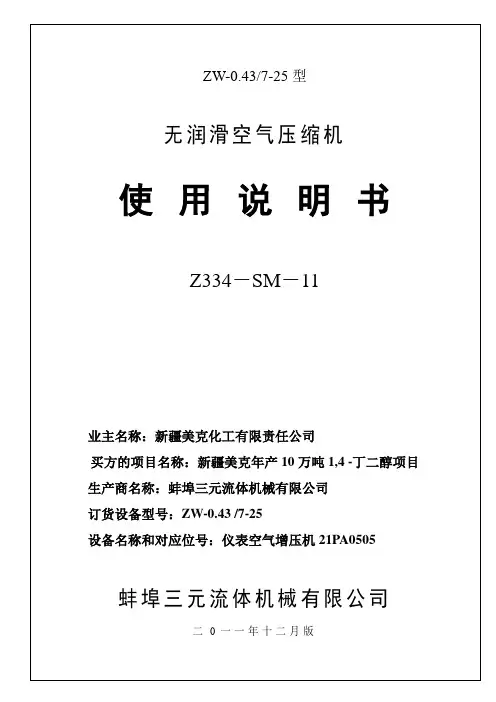
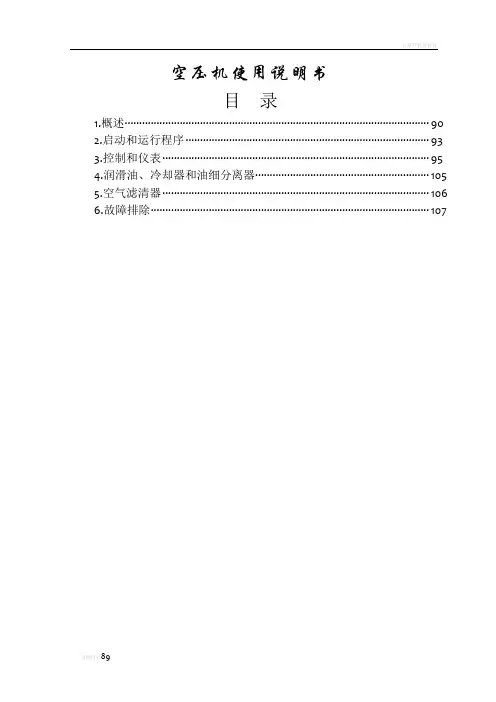
一、日常开机前检查空压机使用说明书目录1.概述 (90)2.启动和运行程序 (93)3.控制和仪表 (95)4.润滑油、冷却器和油细分离器 (105)5.空气滤清器 (106)6.故障排除 (107)1.概述压缩机:原装进口的螺杆压缩机主机是一靠啮合的螺旋形转子进行压缩的单级容积式回转机械。
两转子都靠安装在压缩腔外的高额定负载转子轴承支承,单一宽度的圆柱滚子轴承装在吸气端承受径向载荷。
装在排气端的圆锥滚子轴承对转子进行轴向定位并承受所有轴向载荷和剩余的径向载荷。
压缩原理(图1-1):压缩是通过主辅转子在一气缸内同时啮合来完成的。
主转子有四个互成90°分布的螺旋形凸齿,辅转子有五个互成60°分布的螺旋形凹槽与主转子凸齿啮合。
空气入口位于压缩机气缸顶部靠近驱动轴侧。
排气口在气缸底部相反的一侧。
图1—1是为了表示吸、排气口的反向视图,当转子在吸气口尚未啮合时,空气流入主转子凸齿和辅转子凹槽的空腔内,此时压缩循环开始。
(见图A)当转子与吸气口脱开时,空气被封闭在主辅转子构成的空腔内,并随啮合的转子轴向移动,(见图B)当继续啮合,更多的主转子凸齿进入辅转子的凹槽,容积减少,压力升高。
喷入气缸的油用以带走压缩产生的热量和密封内部间隙。
容积减少,压力升高一直持续到封闭在转子内腔中的油气混和物通过排气孔口排入油气桶内的时候。
为了生成一个连续平稳无冲击的压缩空气流,转子上的每一容积都以极高的连续性遵循同样的“吸气——压缩——排气”循环。
压缩机系统的空气流程(图4—1):空气进入空气滤清器,流经吸气卸荷阀进入压缩机,经压缩后,油气混合物进入油气桶内,在那里,大多数带走的油通过速度变化和撞击从空气中分离出来,并落入油气桶内。
空气和残留的油进入分离器,在那里油被分离并通过分离器壳体与压缩机之间的连接管道流回压缩机。
空气流经压力维持阀,排气止回阀和冷却器,然后进入车间空气管线。
润滑、冷却和密封:油气桶内的空气压力驱使润滑油流过油冷、热控阀和油过滤器,排入压缩机主油路。
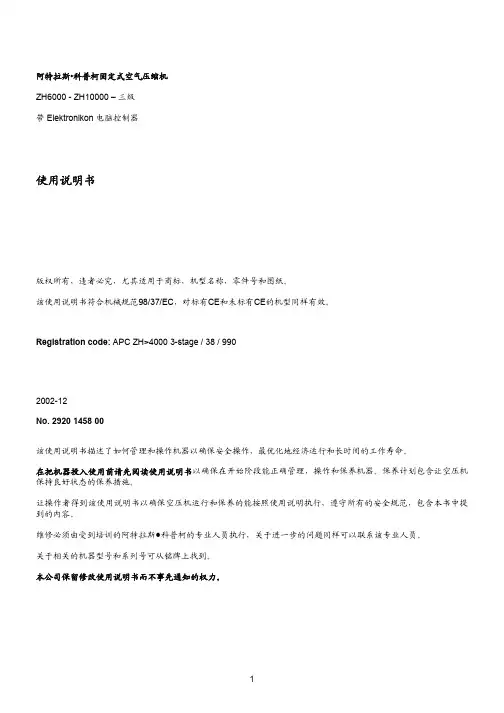
阿特拉斯•科普柯固定式空气压缩机ZH6000 - ZH10000 – 三级带 Elektronikon 电脑控制器使用说明书版权所有,违者必究,尤其适用于商标,机型名称,零件号和图纸。
该使用说明书符合机械规范98/37/EC,对标有CE和未标有CE的机型同样有效。
Registration code: APC ZH>4000 3-stage / 38 / 9902002-12No. 2920 1458 00该使用说明书描述了如何管理和操作机器以确保安全操作,最优化地经济运行和长时间的工作寿命。
在把机器投入使用前请先阅读使用说明书以确保在开始阶段能正确管理,操作和保养机器。
保养计划包含让空压机保持良好状态的保养措施。
让操作者得到该使用说明书以确保空压机运行和保养的能按照使用说明执行,遵守所有的安全规范,包含本书中提到的内容。
维修必须由受到培训的阿特拉斯●科普柯的专业人员执行,关于进一步的问题同样可以联系该专业人员。
关于相关的机器型号和系列号可从铭牌上找到。
本公司保留修改使用说明书而不事先通知的权力。
内容页次1 导论 4概述 4 1.1空气流程8 1.2冷凝液排污系统8 1.31.4油系统9冷却系统14 1.5电气系统14 1.61.7电脑控制器14 Elektronikon控制空压机的排气量151.7.1保护空压机161.7.21.7.3监控元件-维修报警16检查起动条件171.7.4控制润滑油系统171.7.5在最小停机时间内的起动命令171.7.6断电后自动重新起动171.7.7空压机状态的外部显示181.7.81.7.9连接系统18 BUS控制面板18 1.8显示屏201.8.1功能键201.8.2滚动键211.8.3紧急停机按钮211.8.4菜单控制式程序23 1.9控制程序的功能231.9.11.9.2主显示屏25查询其它的菜单251.9.31.9.4返回主屏幕或其它菜单25主屏幕菜单251.9.5状态参数菜单261.9.61.9.7测量参数菜单28运行小时菜单301.9.8保养菜单311.9.9测试菜单331.9.10修改设定值菜单331.9.11修改调节参数设定值331.9.12修改保护设定参数351.9.13修改保养设定值371.9.14每周时钟菜单381.9.15配置菜单411.9.16储存参数菜单421.9.17显示更多的菜单421.9.18卸载/加载菜单431.9.192 安装建议44外形尺寸图44 2.12.2 安装建议462.3 安装出口管路49橡胶补偿器类型492.3.12.3.2 同心度偏差492.4 冷却水要求50冷却系统的类型512.4.12.4.2 冷却水的参数51图标542.53 操作指南56第一次开机的准备56 3.1空压机的控制模式57 3.2在起动前57 3.3起动59 3.4例行开机593.4.1紧急停机或故障停机后起动593.4.2起动的次数593.4.3在运行中61 3.5检查显示屏613.5.1手动控制空压机的运行62 3.6停机62 3.7停止运行633.84 保养64空压机的预防性保养计划64 4.1电机的油脂65 4.2润滑油的规范65 4.3安装后的保存要求66 4.4保养包664.55 保养步骤67空气过滤器67 5.15.2油和油过滤器的更换67除油雾器695.36 常见故障及其解决办法717 重要参数72显示屏上的读数72 7.1可编制的设定值72 7.2断路器-电机类型72 7.3断路器727.3.1电机类型737.3.2空压机性能参数74 7.4设计条件747.4.1限值747.4.2噪音声压级747.4.37.4.4 7 bar - 50 Hz 空压机性能参数757.4.5 8 bar - 50 Hz 空压机性能参数757.4.6 9 bar - 50 Hz 空压机性能参数757.4.7 10.4 bar - 50 Hz空压机性能参数767.4.8 100 psi - 60 Hz 空压机性能参数767.4.9 115 psi - 60 Hz 空压机性能参数767.4.10 130 psi - 60 Hz 空压机性能参数777.4.11 150 psi - 60 Hz 空压机性能参数77公制和英制/美制的换算表777.58 可编制的设定值79调节设定值79 8.1保护设定值79 8.2保养设定值808.39 可选装置8210 安全措施841 导论1.1 概述ZH6000 和 ZH10000是三级水冷离心压缩机,它提供无油,无压力波动的压缩空气,空压机由电机驱动。
STATIONARY SCREW AIR COMPRESSOR OPERATION & MAINTENANCE MANUAL 螺杆空气压缩机使用和维护说明书在安装或第一次起动压缩机前,请仔细阅读本手册,清楚了解压缩机的有关知识以及操作维修的注意事项。
请把本手册与机器一同移交使用者。
本技术手册内有重要的安全信息,应一直与压缩机一起保存。
德斯兰压缩机(上海)有限公司DESRAN COMPRESSOR(SHANGHAI)CO.,LTD.目录安全说明 (2)技术参数表 (4)第一章总论 (5)1.1概述 (5)1.2系统流程 (5)1.2.1空气系统 (6)1.2.2润滑系统 (6)1.3冷却系统 (7)1.4控制保护系统 (7)1.5电气系统 (7)1.6微电脑控制器 (9)第二章安装 (10)2.1压缩机的安装场所 (10)2.2电气安全要求 (11)第三章操作 (12)3.1首次开机 (10)3.2日常运行 (13)3.2.1开机 (13)3.2.2压缩机运行状态 (13)3.2.3停机 (14)3.2.4 运行中注意事项 (15)3.3 长期停机 (15)3.3.1准备 (15)3.3.2重新开机 (15)第四章维护保养 (16)4.1 润滑油 (16)4.1.1换油周期 (16)4.1.2更换油和油过滤器 (16)4.2 消耗品保养与更换 (17)4.2.1空气滤清器的保养 (17)4.2.2油过滤器的保养 (17)4.2.3油气分离器的保养 (17)4.2.4清洁冷却器 (18)4.2.5安全阀 (18)4.3预防性保养计划 (19)第五章故障分析与排除 (20)5.1概述 (20)5.2压缩机故障及排除方法 (20)安全说明请仔细阅读并理解一般注意事项,然后再阅读其余各条安全规则。
1.一般注意事项a.设备的搬运就位、安装、操作、保养和检查,都必须由经过良好培训的人员来进行。
b.如果用户自行改动了设备,对于由此导致的人身伤害和设备故障或损坏,我们不承担责任。
目录安全警示主要技术规格压缩机的概述压缩机的起吊、安装与试运转压缩机的使用和维护压缩机的定期维护压缩机安全技术压缩机的拆卸与装配压缩机的常见故障用及其排除压缩机的油封储存主要零、部件装配间隙随机出厂图样附:固定式压缩机安全规则和操作规程(摘录于GB10892-89)Q/GY 191001-2008往复活塞式压缩机安全警示为保证压缩机安全可靠的运行,除按说明书的规定操作外,尤其要遵循本安全警示。
1.压缩气体、电的使用都必须注意安全!防止人身伤害事故和设备损害事故发生,压缩机安装场所必须设臵安全警示标志。
2.应选派具有一定资格的人员作为气体压缩机管理人员,指定受过训练的人员操作、维护气体压缩机。
该类人员必熟知GB10892-1989《固定的空气压缩机安全规则和操作规程》的规范要求。
3.电机及电控设备须可靠接地。
4.禁止使用明火察看压缩机或压力容器内部。
5.储气罐、后冷却器等钢制压力容器必须按照《压力容器安全技术监察规程》及GB150-1998《钢制压力容器》等法规和标准使用维护和定期检查,并接受国家安全监察机构的管理和监察。
6.润滑油积碳会引起压缩机爆炸;超过规定的排气温度,使用不合规定的润滑油,油水在排气管道、储气罐内未及时排放,积聚太多,都有可能引起积碳和爆炸。
当无润滑压缩机刮油圈和挡油圈失效及密封件磨损后,润滑油很容易进入气缸,所以对有油压缩机和无润滑压缩机的气缸、排气管道、储气罐、附件等都要定期消除积碳,并更换失效元件。
7.压缩机承压零件如:缸体、缸座、缸盖、级间冷却、分离器、储气罐,因气流冲刷及水腐蚀会造成以上零件厚度减薄,必须定期清洗及测量其厚度,并按规定进行水压试验检查。
清洗剂不应使用易燃液体。
8.压缩机运转前,安全阀、压力表及各项保护装臵必须安装到位,检查各项保护装臵的正确性、灵敏性、可靠性,使其处于完好状态,并定期检查校验系统中的安全阀、压力表、温度计、继电保护装臵等仪表和安全连锁保护装臵。
PISTON COMPRESSOR MANUAL REV022621Contents Safety Information 2-3 Breathable Air 3Pressurized Components 3Personal Protective Equipment 3 Nomenclature 4 Features and Extras 5-7 Pump Riser 5Belt Tensioner 5Continuous Run 6Automatic Tank Drain 7 Installation 8-16 Area 8Lifting and Movement 9General Lifting 9Anchoring 10Electrical 11-14 Piping 15-16 Pre-use Inspection 17 Operation 18Pump Times 18 Maintenance 19-20 Maintenance Schedule 19-20 Oil Change/Selection 20Oil Disposal 20 FAQ and Troubleshooting 21 Warranty Information 22-24SAFTEY INFORMATIONThis manual contains very important information to know and understand. This is to provide for SAFTEY and to PREVENT EQUIPMENT PROBLEMS. To help understand this information, observe the following:DANGER:Danger indicates and imminently hazardous situation which, if not avoided, will result in death or serious injury.WARNING: Warning indicates a potentially hazardous situation which if not avoided, could result in death or serious injury.CAUTION:Caution indicates a potentially hazardous situation which, if not avoided, may result in minor or moderate injury.NOTICE:Notice indicates important information, that if not followed, may cause damage to equipment.CALIFORNIA PROPOSITION 65WARNING:This product or its power cord may contain chemicals known to the state of California to cause cancer and birth defects or other reproductive harm. Wash hands after handling.1.Allow only trained, authorized persons who have read and understood these operating instructions to use thisequipment. Failure to follow the instructions, procedures and safety precautions in this manual can result inaccidents and injuries.2.NEVER start or operate the compressor under unsafe conditions. Tag the compressor, disconnect,and lock out all power to it to prevent accidental start-up until the condition is corrected.3.Install, use, and operate the compressor only in full compliance with all pertinent OSHAregulations and all applicable Federal, State & Local codes, standards, and regulations.4.NEVER modify the compressor and/or controls in any way.5.Keep a first aid kit in a convenient place. Seek medical assistance promptly in case of injury. Avoidinfection by caring for any small cuts and burns promptly.BREATHABLE AIR1.NEVER use air from this compressor for breathable air except in full compliance with OSHA Standards 29CFR 1910 and any other Federal, State or Local codes or regulations.2.DO NOT use airline anti-icer systems in air lines supplying respirators or other equipment used to producebreathable air. DO NOT discharge air from these systems in unventilated or other confined areas.Pressurized ComponentsThis equipment is supplied with an ASME designed and rated pressure vesselprotected by an ASME rated relief valve. Pull the ring before each use toensure the valve is functional. DO NOTattempt to open the valve while themachine is under pressure. See figure on the right.Personal Protective EquipmentBe sure all Be sure all operators and others around the compressor and its controls comply with all applicable OSHA, Federal, State and Local regulations, codes, and standards relating to personal protective equipment. This includes respiratory protective equipment, protection for the extremities, protective clothing, protective shields and barriers, electrical protective equipment, and personal hearing protective equipment.NomenclatureFeatures and ExtrasCompressors come in many shapes and sizes. Our units have several features that may or may not be present on your unit. These features may be purchased after the fact in kit form. This guide will explain the use and benefit of these features.Pump RiserBelt TensionerContinuous RunContinuous run allows the pump to turn continuously, hence the name. In this mode the unit pumps up to 140 PSI and then the valves are held close. This allows the pump to enter a free spin state where the unit is pulling in cold air and the simply cycling it back to atmosphere. This has several benefits:1.The pump is cooled during the free spin state since it has no pump load on it.2.Increased recovery time since the function cycles between 100 and 140 PSI; which is the optimal CFMwindow for the unit.3.Wear on your motor is decreased (especially single-phase units) as the unit is already in motion and will notneed the large amp draw to overcome zero movement and fight tank compression.4.Continuous run is best used in applications where CFM cannot be lost. Some examples of this are: mediablasting, painting, and prolonged grinding or resurfacing.Auto DrainAuto drains are preset timer valves that allow tank moisture to be vented as long as they are powered. The enemy of every compressor/air system is moisture. The auto drain removes some of the hassle of this by allowing the user to set a timer and walk away from the unit with the piece of mind that their system is protected.1. The drain works off a conventional 120V outlet.2. Timer has built in intervals that can be customized to the user need.3. Has a manual shut off for service and maintenance.4. The drain filter MUST be cleaned weekly to prevent drain blockage.5.Drain time knob, marked as ON:SEC , corresponds to how long the drain will run for when it comes on. This is listed in seconds.6. Drain interval knob, marked as OFF: MIN , corresponds to how long between cycles. Or how long the drainwill be OFF before it comes on again.7. The drain attaches to a ½” NPT female connection.8. The vent can blow to atmosphere; however, the drain is supplied with a drain silencer system which can beused to muffle the sound of the unit draining. This screws into the atmospheric vent location, however, it is not necessary for operation.9.A drain system can also be equipped by the user to allow moisture to drain to a separate location.10. The drain is also equipped with a test button to check function.InstallationArea1.Install compressor in a clean, dry, and well-lit area. Be sure installation area can maintain a temperaturerange between 35˚ - 110˚F.2.Allow sufficient space around the compressor for maintenance access and adequate airflow. Mount unit withthe belt guard (pulley and flywheel) side to the wall and leave a minimum of 15 inches of clearance.3.If acid is used in operating environment or air is dust laden, pipe intake to outside fresh air. Increase pipe sizeby 1/8”’ for every 20ft of run. Be sure to install a protective hood at the outside air intake location to prevent debris and foreign objects from blocking the intake pipe.4.In operating environments where excessive water, oil, dirt, acid, or alkaline fumes are present, a TEFC (totallyenclosed, fan cooled) motor is highly recommended. Check nameplates for motor type.5.Insulate cold water or tother low temperature pipes that pass overhead to avoid condensation dripping onthe compressor.6.In environments where fine dust is common such as granite, marble, or concrete plants the unit must beinstalled in a separate room with its own dedicated ventilation system.7.The unit can be stored outside under the following guidelines: It must be in a covered area out of extremeweather with no ability for moisture to get to the unit, it is also highly recommended that the unit is out of direct sunlight as it can fade and/or damage the coating on the unit. Direct sunlight may also interfere with safety decals on the unit.8.If the unit is in an enclosed space it requires proper ventilation as the ambient air temp where thecompressor is located CANNOT exceed 115 degrees F.e shims to level the compressor if installation area is not flat. This will help prevent excessive vibration andpremature pump wear.Lifting and Movement/Forklift1. Make sure lift operator stays aware while moving the compressor.2. Be sure to uncrate the compressor prior to movement. This will allow a visual reference for the balance ofthe unit.3. Be sure the load is secure and well balanced before moving the compressor.4. Make sure the forks are fully engaged and level prior to lifting or moving the unit.5. Keep the unit/load as low as possible while moving and refrain from quick changes in direction.6. For all other forklift safety standards/regulations please reference OSHA 1910.178- Powered industrialtrucks.General Lifting Information1. Carefully inspect all lifting equipment and ensure it is in good condition. Rated capacity of lifting equipmentmust exceed compressor weight. NEVER lift with under sized or damaged equipment.2. If using lifting equipment, ensure all lifting points are in good condition and tighten any loose nuts or boltsbefore lifting.3. A sling MUST be used when moving the compressor with a helicopter or other airborne equipment. Be sureto follow OSHA standards 1910 subpart N.4. Use guide ropes or equivalent to prevent twisting or swinging of the compressor while it is in the air andNEVER attempt to lift the unit in high winds. Keep compressor as low to the ground as possible.5. Keep all persons away from the compressor when it is lifted. DO NOT allow persons under the compressorwhile it is being lifted.6. DO NOT use bolts or other hooks on individual components to move the compressor.7. When moving and or placing the compressor ensure it is on/across a surface that can hold the combinedweight of the compressor and the loading equipment.AnchoringTo ensure proper and safe operation of the compressor the unit is required to be anchored to a flat, smooth,concrete floor. Compressors are also required to be on ¼ inch (6.35mm) MAXIMUM thick rubber anti-vibration pads.Recommended anchor Bolt specifications: wedge anchors; 3/8 in width by 3.5 in length.How to Anchor the Compressor1. Make sure the compressor is in the desired location and the anti-vibration pads are under the feet of thecompressor.2. Using the holes in the feet as guides, drill the holes for the anchor bolts through the vibration pads and intothe concrete.3. Thoroughly clean each hole.4. Put the Washer and Nut into place, make sure the top of the Nut is flush with the top of the anchor bolt, theninsert the anchor bolt into the hole.5. Hammer or mallet the anchor bolt down into the hole.6. Tighten each nut clockwise , DO NOTover tighten. DO NOTuse an impact to tighten the anchors.Electrical Safety1. Follow all NEC and local codes for electrical wiring. Allow only authorized service personnel or certifiedelectricians to install electrical components.2. Put unit on a dedicated circuit and make sure no other electrical equipment is wired into it. Failure to wireunit on an independent circuit can cause circuit overload and/or imbalance in motor phasing. Install proper No Fuse Breaker (NFB) according to the chart listed below. You may also reference NEC and local codes for additional support.3. Ensure incoming service has adequate ampere rating.4. Do not used mixed wire sizes when wiring the unit.5. The unit must be properly grounded. DO NOT connect ground to air or cooling lines.Wiring the Compressor1. Voltage should not vary more than 12% to ensure proper operation of the compressor.2. Wire size and breaker requirements for single phase units:**3. Wire size and breaker requirements for 3 phase units:**Wire size distances are from unit to the panel where the breaker is housed.**CAUTION: Under sizing wires and/or breakers can cause damage to the unit, possible injury to personnel, and void your warranty.4. Single phase unit, NO magnetic starter:5.Single phase unit WITH magnetic starter:6.Three phase unit wire diagram (Three phase will ALWAYS have magnetic starter):7.During initial start up of 3 phase unit, pay attention to flywheel rotation. When facing the front of thecompressor (Pressure switch/pressure gauge side) rotation should be clockwise. If rotation iscounterclockwise, switch incoming power leads at 3L2 and 5L3 (ensure power is off at the breaker before attempting any changes).Piping (Safety steps)1.Install appropriate flow-limiting valves as necessary according to pipe size(s) used and run lengths. This willreduce pressure in case of hose failure, per OSHA Standard 29 CFR 1926.302(b)(7).2.Flow-limiting valve are listed by pipe size and rated CFM. Select appropriate valves according tomanufacturer’s recommendations.e a flexible connector between compressor tank and dryer/piping system to minimize noise, vibration,pump wear, and to prevent damage to the unit or piping system.4.Install ASME code safety valves and ensure piping system is equipped with adequate condensate drains.5.Minimum pipe size for compressed air lines: (Pipe sizes are shown in inches)PISTON COMPRESSOR MANUAL REV0226216.Air systems should be checked daily for leaks. This helps to prevent unnecessary load on the compressor andhelps increase energy savings.7.Examples of air systems:Closed loop system. Install tee fitting in piping from air to minimize pressuredrop and to allow air flow in two directions.Air DropAir Drop: Install tee fitting withbranch to top to minimizecondensation.From CompressorElevation View8.Make sure any tube, pipe, fitting, or hose connected to the unit can withstand operating temperatures andretain pressure.9.Never use reducers in discharge piping. Keep all piping and fittings the same size in the piping system.WARNING: Never use plastic (PVC) pipe for compressed air. Serious injury ordeath could result. Piping MUST have a pressure rating of 200 PSI or greater.Pre-Use Inspection1. The unit is shipped with pump break-in oil and should be ready to operate. Be sure to check for proper oil levelbefore running the compressor. Break in oil should be change after 100 Hours of operation (active pumping time). See maintenance section for more information on oil changes and frequency.2. Check for proper belt tension. There should be ½ inch of belt slack/deflection. Refer to maintenance section ifadjustment is necessary.3. Inspect belts for frays or unit for an excess buildup of black rubber dust indicating belt wear.4. Check proper operation of all pop off safety valves on unit. Pull rings on valves to ensure they move and are freeof any obstructions. DO NOT pull the safety valve on the tank if there is air in the tank!5. Inspect all air lines/piping for proper for secure fit and corrosion or line degradation. DO NOT operate thecompressor with damaged lines. DO NOT use damaged or cracked air lines as a rupture could result in damage/injury to personnel or property.6. WITH UNIT LOCKED OUT (power off at source i,e. the electrical panel/disconnect) ensure all electrical wiring,including all terminals, are in good condition and are free of buildup, fraying, cracks or discoloration replace as needed. Check tightness of bolts securing wiring in place.7. Ensure unit is secured in place and has not shifted. Verify anchor bolts are in place and are in good condition. 8. Remove any loose items from around/on compressor to avoid damage to the unit. Examples would be looseclothing items, rags, papers, bottles, or any item that may have been placed on the unit. 9. Check unit for any oil leaks. If leaks are found contact manufacturer for further instructions. 10. Unit should NEVER be operated without the belt guard in place.11. Inspect Flywheel for cracks or missing fins. NEVER operate a unit with a damaged flywheel; serious injury ordeath could result. If you suspect your flywheel may have been damaged, contact technical assistance and DO NOT allow the machine to be operated.Ensure all personnel that work around or operate the compressor have read this manual and are well versed in the operation of this machinery. NEVER allow untrained personnel to operate this unit.1. Once the inspection is completed, open your discharge port (outlet ball valve). This should already be connectedto your shop airline system.2. Ensure all personnel are clear of the compressor and aware that it is being started.3. Turn the selector on your pressure switch to AUTO. This will start your compressor and allow it to fill. The tankwill fill to 175 PSI, and unless otherwise noted, will shut off. The unit will begin pumping again once the tank is drained down to approximately 135 PSI. ***This may vary based on features, if your unit is equipped withCONTINOUS RUN , the unit may perform differently then specified in this step. (Check the FEATURES section for more information)4. Oil pressure on start up will vary due to ambient temperatures but should not exceed 100 PSI. Once the unit isallowed to run a few cycles and come to optimal operating temperature, oil pressure should stabilize at 20-35 PSI. If the oil pressure remains high or drops too low, it can be adjusted as follows:Pump Up Time (General)Compressor maintenance must be performed as described in the maintenance schedule, failure to do may lead to compressor/component breakdown and void compressor warranty.Maintenance ScheduleThe table below is a generalized maintenance schedule based on the normal usage of a compressor. Your specific needs may vary based on operating environment and duty.Frequency of these changes are a generalization and may be subject to change based on compressor environment, hours, and application.Oil ChoiceIt is strongly advised to use only Airbase Industries piston compressor oil. Check with your warranty/extended warranty guidelines to verify oil selection and use. Oil used in the compressor must fall under the following criteria: synthetic, SAE grade 30, non-detergent, piston compressor oil.Oil DisposalCompressor oil is not trash and MUST NOT be disposed of in regular trash or discarded into the environment. You MUST dispose of waste oil from your unit per all applicable federal, state, and/or local codes. Failure to do so may damaged the environment and subject yourself and/or your business to fines and legal issues.TroubleshootingSome unit issues can be fixed simply by verifying the following guide. It is advised to go through the guide prior to calling technical support to help expedite the assistance process.Warranty Statement•Standard Warranty: That each compressor unit is free from defects in material, workmanship, and parts for1 year from the date of delivery. This Standard Warranty includes 1 year of warranty labor from anauthorized technician. Manufacturer is not responsible for downtime during warranty service. If downtime is necessary, it is at the owner’s discretion, obligation, and expense, to h ave a redundant compressor.• Parts shipped for warranty repairs shall only include ground freight charges for the first 90 days of the warranty period, thereafter owner is responsible for all freight charges of parts shipped for warranty. Any and all expre ss shipping charges of warranty parts would be at the owner’s expense. Standard technicalassistance is provided at no charge during and after the standard warranty period.*Standard warranty has no obligation to maintain warranty status, warranty will expire one year from date of delivery. Please see available options below to extend your warranty.•Extended Warranty: Manufacturer will extend your standard 1-year warranty to full 5 years when you opt to register for the extended warranty plan that includes using our SMART OIL™ and following all routinemaintenance set forth. Parts shipped for warranty repairs shall only include ground freight charges for the first90 days of the warranty period, thereafter owner is responsible for all freight charges of parts shipped forwarranty. Any and all express shipping charges of warranty parts would be at the owner’s expense. Standard technical assistance is provided at no charge during and after the standard warranty period.Required maintenance schedule to maintain warranty status.➢All units are shipped with break-in oil and must be changed no less than 70 hours to i nsure gasket seating.➢After the 100 hours of break-in, you must change the oil.➢Thereafter Oil Should be changed every 6 months or 1000 hours whichever occurs first.➢Always maintain proper oil level in unit. If the unit runs out of oil due to neglect the warranty w ill be void.➢Use only manufacturer approved oils in your compressor, or your warranty is void.➢All stock orders by vendor/purchaser are required to purchase two service kits at time of purchase per unit.➢All stocking orders will have a 6-month grace period for warranty registration. After that time the unit must be registered, or warranty may be void.**Extended Limited Lifetime Pump Warranty With participation in our SMART OIL™ extended auto shipprogram will extend your warranty plan to **Limited Lifetime Warranty on the pressure lubricated pump.All other non-wear and tear components to 10 years. SMART OIL™ not only extends the life of yourcompressor pump, it also can reduce operating noise levels and can create further energy savings.Warranty repair parts under the Limited Lifetime warranty will not include any shipping charges beyondthe Standard Warranty, therefore owner is responsible for all freight charges for warranty parts. This planincludes our advanced technical air support. Smart Tech Support provides you with the highest level oftechnical support. Smart Tech support is an interactive support team available to you at your fingertips byjust downloading a free app. The app provides free remote meetings, interactive touch display, real livepersonal to assist.Limited Lifetime Warranty is not prorated and has no hour limits.**Limited Lifetime Warranty, non-prorated, no hour limits. In the case the product has been discontinuedat any point the Limited lifetime Pump warranty will last five years past the discontinued date. Warrantorhas discretion to substitute parts with current model for the five-year duration.*In order to maintain Limited Lifetime Warranty status, the owner must adhere to and purchase the required maintenance items as scheduled below utilizing our Smart Whisper Blue Auto Ship program:Required maintenance schedule to maintain warranty status.➢All units are shipped with break-in oil and must be changed no less than 70 hours to i nsure gasket seating.➢After the 100 hours of break-in, you must change the oil.➢Thereafter Oil Should be changed every 6 months or 1000 hours whichever occurs first using only our Smart Whisper Blue Oil➢Always maintain proper oil level in unit. If the unit runs out of oil due to neglect the warranty w ill be void.➢Use only Smart Whisper Blue Oil and filters purchased from original manufacturer in y our compressor, or your warranty will be voided.➢Must be an active member of auto ship program.➢All stock orders by vendor/purchaser are required to purchase two service kits at time of purchase per unit.➢All stocking orders will have a 6-month grace period for warranty registration. After that time, the unit must be registered, or warranty may be void.•Warranty shall not apply, and manufacturer shall not be responsible nor liable for:➢Routine service such as oil changes, filter replacements, gasket tightening t o correct oil seepage or drive belt tightening and valve cleaning and are not covered under warranty.➢Consequential damages such as but not limited to cost of loss of business, product damage, or down time.➢Acts of nature, over abuse, malicious destruction, improper maintenance, undersized equipment➢In the case the product has been discontinued at any point the *Limited lifetime warranty w ill last five years past the discontinue date. Manufacturer has discretion to substitute parts with currentmodel for the five-year duration.➢Deviation from operating instructions or specifications➢Labor charges for repairs or maintenance made by person(s) other than an authorized, a pproved service technician or any labor after the 1-year Standard Warranty expires.➢Normal wear and tear parts included but not limited to valves (intake/suction, check, b lowdown, thermo, pop off, unloader), and ball valves. Belts, shaft seals, load/unloader solenoids, sensors(temperature or pressure), Electrical contractors and relays, and any parts with a routinemaintenance scheduleWarranty shall be voided under the following conditions: Exposing electrical components to rain or water or installing the unit in a hostile environment such as acid vapors or any caustic or abrasive matter that may be ingested into the pump or installing the unit in an enclosed area where lack of cooling ventilation is present, such as in boiler or equipment rooms where the ambient air exceeds 100F.Further exclusions include failure to fully and completely follow the guidelines set forth in the manual. Of specific note is environments where fine dust is common, such as granite, marble or concrete plants, the compressor MUST be installed in a separate area with its own dedicated ventilation. FAILURE TO PROVIDE THIS DUST FREE OPERATING AREA VOIDS THE WARRANTY.Parts used for warranty purposes must be supplied by original manufacturer. Warranty work should be performed only by an approved technician. If any maintenance (other than routine maintenance) is performed by a non-approved Technician, written pre-approval must be obtained from manufacturer, to prevent voiding this warranty. Failure to fully comply with this warranty and fully comply with the manual instructions will void this warranty.The oil purchase and maintenance program are effective as of Jan.2020。
螺杆式空气压缩机控制器操作说明书Contents Page 1按键说明——————————————————————————22界面说明——————————————————————————33操作说明——————————————————————————74保养部件提示————————————————————————85故障报警和处理———————————————————————9附1基本参数说明表———————————————————————10附2电气原理图—————————————————————————121、按键说明2、界面说明1)开机和主页面检查紧急停止按钮,使其处于打开状态。
控制器通电后,文本显示器液晶背光亮。
控制器上电后,进入欢迎页面:当通讯成功后自动进入主页面:2)查询菜单在主页面下,按‘设置’键,进入菜单选择:键操作)i.系统状态(SYS STAT)菜单在查询菜单下,选择系统状态,进入系统状态查询:符号提示区:2006年日12:00:00按‘↓’键:符号提示区:空车时间:小时ii.维护查询(M.I.PAGE)菜单在查询菜单下,选择维护查询,进入维护参数查询:符号提示区:空滤剩余时间:1234小时按‘↓’键:油滤剩余时间:1234小时按‘↓’键:按‘↓’键:按‘↓’键:注:此页面只有在皮带传动的设备上才能显示;对于齿轮传动的则显示齿轮油使用时间iii.参数设置(PARA SET )菜单参数设置内含“风机测试”及“加载阀测试”功能参数,此两项参数只有在正常停机状态下才会显示,并可进行调试。
运行状态或紧急停机状态下该参数不显示。
油分剩余时间:1234小时润滑油剩余时间:1234小时皮带剩余时间:1234小时3)操作指示i.密码输入说明:12、密码输入错误,页面会提示:‘密码或权限错误!’,然后重新回到密码设置。
密码输入说明:1、按页面所示校验码,输入系统密码。
2、密码分为两级:用户级密码(二级),工厂级密码(一级)。
神钢空压机使用说明书一、产品简介神钢空压机是一种高效、可靠的压缩空气设备,广泛应用于制药、食品、化工、电子、纺织等行业。
其主要功能是将大气中的空气通过压缩机压缩,提供给设备或工艺过程所需的压缩空气。
二、产品特点1. 高效节能:神钢空压机采用先进的压缩技术,能够在保持高效工作的同时,最大限度地降低能源消耗。
2. 稳定可靠:该空压机采用高品质的压缩元件和控制系统,保证了设备的稳定运行和长寿命。
3. 操作简便:神钢空压机具有人性化的操作界面和智能化的控制系统,操作简单方便,可实现自动化控制。
4. 多种型号可选:根据不同行业和用户需求,神钢空压机提供多种型号和规格的产品选择,满足不同场景下的需求。
三、安装与调试1. 安装位置选择:空压机应安装在通风良好、干燥清洁的室内环境中,远离易燃、易爆物品。
安装地面应平整坚固,并具备足够的承重能力。
2. 连接电源:根据空压机的额定电压和电流要求,正确接入电源,确保电源可靠、接地良好。
3. 连接气源:将空压机的进气口与干燥、过滤的空气管道连接,并确保连接牢固,无漏气现象。
4. 连接排气管道:将空压机的排气口与排气管道连接,确保排气畅通。
四、操作与维护1. 启动与停机:在确认安装正确并接通电源后,按下启动按钮,空压机将开始运行。
停机时,先按下停机按钮,待空压机完全停止后再切断电源。
2. 运行监测:定期检查空压机的运行状态,如压力、温度等是否正常,如有异常情况应及时处理。
3. 滤芯更换:空压机的滤芯应定期更换,以保证气源的洁净度。
4. 润滑油更换:根据使用时间和使用环境,定期更换润滑油,确保润滑系统的正常运行。
5. 清洁维护:保持空压机的外部清洁,定期清理灰尘和杂物,并注意定期检查紧固件是否松动。
五、故障排除1. 电源故障:检查电源是否接通、电压是否稳定,如有问题应及时联系专业人员进行检修。
2. 过载保护:空压机在运行过程中如出现过载情况,应立即停机检查,确定原因后进行处理。
YC90L-4空气压缩机使用说明书 编号:2009056 目录:
1.YC90L-4型空气压缩机主要技术规范
2.压缩机主要部件简述 3.压缩机的安装要求 4.压缩机的试运转 5.压缩机的正常操作 6.压缩机可能发生的故障及消除 7.压缩机的检修 8.压缩机的启封 9. 附录A:机体与电机的安装 1.ZW-22.5/8型空气压缩机主要技术规范 (1)型式:立式、两列、二级、双作用、水冷、气缸无润滑
(2)输气量1350m3/h±5%(吸入状态) (3)吸入介质状态: 大气吸入 进气压力:当地大气压 进气温度:≤35℃ (4)最终压力:0.8MPa(G) (5)末级冷却器后出气温度:≤40℃ (6)气缸直径:一级缸φ430mm,二级缸φ250mm (7)活塞行程:180mm (8)转速:590r/min (9)曲轴旋转方向:从油泵端看为逆时针方向 (10)传动方式:皮带轮传动 (11)轴功率:132kW (12)压缩机总重量:~6000kg(包括电动机、辅机、管道) (13)电动机:型号Y315M-4 电压 380V 转速 1485r/min 功率 132kW (14)冷却水压:进水压力 0.3Mpa(G); 回水压力 0.25Mpa(G) (15)冷却水进水温度: 〈30℃ (16)却水耗量:~15T/h (17)一级进气管径:φ219×6 (18)末级出气管径:φ133×4 2.压缩机主要部件简述 本机主要由机身、曲轴、连杆、十字头、刮油器、油过滤器、油冷却器、机带油泵、动力装置、气缸、活塞、气阀、密封器、高效气体冷却器、管路系统以及压缩机控制柜等部件组成。 气体的压缩过程见随机图纸Y201.LC流程图。 2.1 机身 压缩机的机身是包括曲轴箱、中间体铸成的整体,其材质为高强度铸铁铸成。 2.2 曲轴 曲轴用稀土球墨铸铁铸成,支承在曲轴箱中的两个轴承上,两列曲拐相差 180度。曲轴一端的飞轮通过皮带与电动机联接,另一端通过超越离合器带动齿轮油泵。曲轴内钻有输油孔,是连杆大头轴承和小轴瓦头润滑油必经通路。 2.3 连杆 连杆体用稀土球铁铸成,小端压入铜套轴衬,大头端轴衬用巴氏合金轴瓦。 十字头为整体式用稀土球墨铸铁铸成。一端用螺纹与活塞杆连接,另一端通过十字头销与连杆小头连接。 2.4 活塞 活塞均为双作用式,由活塞体、活塞杆、活塞环、导向环、挡油圈组成。 活塞体用铝合金铸成。导向环和活塞环均用填充聚四氟乙烯制成,具有较好的 自润性和耐磨性。导向环为T形开口环,使其在更换时更为方便。 2.5 气阀 进、排气阀门均为网状式,具有无导向相对磨损的优点,所有零件均用不锈钢制造。 2.6 密封器 密封器由一环阻流环、三组密封盒及末端密封环组成。阻流环起到节流均压减少气流脉冲的作用,每组密封盒内有三个不同的环,一个径向切口环和一个切向切口环,作为密封件,另一个无切口的支承环,其作用是防止上述二种密封环在压力作用下发生边角冷流,各密封环均用填充聚四氟乙烯制成。 为了避免活塞杆温度过高,在换用新密封环时,应先进行无负荷跑合运转。 2.7 刮油器 刮油器由刮油器体、刮油环、挡油环等组成。其中二道刮油环由ZCuSn10Pb1磷青铜制造,分别置于刮油环上下的二道挡油环由填充聚四氟乙烯制成。刮油器作用是阻止油液、油雾随活塞杆上下运动而被引入密封器并进入气缸,而影响气体质量。 2.8 仪表及控制柜 本机的仪表盘直接带在机身上。仪表盘布置有三个压力表,四个声光报警器及启动停止按扭。电器控制柜为独立一只柜,控制信号线通过导线与机上仪表盘连接。其控制值由Y201.LC流程图上规定的值设定。 3. 压缩机的安装要求 3.1 压缩机的基础 3.1.1 按照压缩机制造厂提供的基础图、及压缩机安装地点的土质条件,进行基础设计。 3.1.2 基础施工应遵守有关土建施工验收规范.严防机组安装后出现基础沉降、断裂、震动等现象。 3.1.3 地脚螺栓预留孔的灌浆工作,必须在机器的初步找平、找正后进行。 3.1.4 二次灌浆必须在机器的最终找平、找正后24小时内进行,一次完成。否则在灌浆前应对机器找平,找正数据进行复测核对。机组的二次灌浆一般要求耐压力为15~17MPa的细碎石混凝土(或400~500号水泥做成的水泥砂浆),要求不得存在蜂窝、孔洞、麻面等缺陷,特别地脚螺栓处的二次灌浆应灌实,不得有空隙。基础的混凝土要求经历过至少二周的养护期。 3.2 安装前的准备工作 3.2.1 去除机器的油封,清洗干净,要彻底清洗并疏通油路通道。如曲轴十字头上之通道,油过滤器及所有的油管等,曲轴箱也应彻底清洗,以保证运转时润滑油的洁净。 3.2.2 将气缸内的密封油清洗干净。 3.2.3 紫铜垫圈预先进行退火处理 3.2.4电机与压缩机间通过皮带轮传动、电机安装在电机底轨上,以便于调整飞轮与皮带轮的联接要求详见附录A 3.3 安装间隙要求 本机在出厂前,主要部位的装配间隙在预装时已调好到设计要求。重新组装时应注意十字头、机身、轴瓦、连杆等零件要对号装入,且连杆钢印号应在铭牌一侧,连杆螺栓应扳紧并用双螺母锁紧防松。对装配间隙应进行复查。 3.3.1 曲轴曲拐直径:φ100mm 曲轴曲拐与连杆大头轴瓦的径向间隙:0.05~0.10mm 3.3.2 十字头销直径:55 mm 十字头销与连杆小轴衬径向间隙:0.04-0.08mm 十字头销与连杆小轴衬轴向间隙:0.15-0.30mm 3.3.3 十字头直径:160mm 十字头与导轨径向间隙:0.12-0.22mm 3.3.4 气缸死隙: 上侧死隙: 2.5-3.5 mm 下侧死隙: 1.5-2.5 mm 3.3.5 导向环 一级 二级 端面轴向间隙: 0.3-0.4mm 0.3-0.4mm 3.3.6 活塞环 一级 二级 轴向间隙 0.2-0.3mm 0.2-0.3mm 径向厚度(新安装时) 18 12 最小径向厚度许可值: 12 7 环搭口间隙(新安装时) 12.6 7.7 3.4 重要部件的安装 3.4.1曲轴安装: 曲轴应清洁,无锈蚀,油孔畅通清洁及无碰撞损伤,按随机图纸W2Z3.5M.20000曲轴结合部图安装。 3.4.2连杆安装: 在曲轴装入曲轴箱前,检查连杆大头瓦与曲柄销之间的间隙。按随机图纸W2Z3.5M.30000装复连杆。间隙可用压软金属丝的方法测得。检查连杆小头轴衬与十字头销之间的配合情况,即青铜轴衬与十字头销的接触面积及间隙。连杆安装到曲轴箱内的方法是先将曲轴结合部在曲轴箱中安装好,然后将连杆体与十字头联接,将十字头带连杆体及轴衬通过机身窗口放入安装列的十字头导轨内,再将曲轴相应安装列曲拐盘动至安装窗口,再按随机图纸W2Z3.5M.30000及图纸上的技术要求安装好轴衬和连杆盖。连杆螺母须用测力扳手和随机工具W2Z3.5M.00002套筒将其扳紧。 3.4.3 刮油器的组装: 刮油环、挡油环均应清洗干净,刮油环安装时应刀刃朝下,挡油环喇叭口大端朝上,刮油环、挡油环在盒座中应能活动自如。 3.4.4 气缸的安装: 气缸头、密封器、气阀均应拆下清洗干净,气缸镜面、气腔与气体接触部位均应清洗干净。先将密封器装入气缸,再平稳地吊起气缸放到机身上同时应用手按压定位销,使气缸正确就位,用锤子将定位销打到位,然后交叉用力拧紧连接螺母。 3.4.5 密封器的组装: 密封器在制造厂已组装好,可拆开检查零件是否洁净,如有必要应进行清洗重新组装。但装时要注意一个密封盒内的密封圈类型上下次序不要调错,检查密封圈在密封盒中的轴向间隙为0.3~0.4mm。用手检查可感到密封圈在盒中能够移动。如有卡死现象,应拆开重新调整组装。 3.4.6 气阀的组装: 所有的气阀均必须拆开,严格清洗,组装时应注意各自的气阀弹簧、定距片不要搞混掉错,要使缓冲片和阀片的斜槽方向一致,不得交错,阀片的磨薄部凹面朝向阀座。安装时注意防止将进气阀装在排气腔。 3.4.7活塞组件的安装:安装前彻底清洗干净并吹干,特别是活塞杆端部与十字头连接的螺纹部分必须擦干净。同时检查活塞环槽的间隙,导向环和活塞环在环槽内能够滑动。若有卡死现象应进行修整后,方可总装。 起吊活塞必须在活塞顶部旋入起吊螺钉方可进行起吊。活塞组件吊入气缸 前取下Y201.20004密封环并必须在活塞杆端部装上Y201.100001护套和0332B.350007装活塞工具。以保护活塞杆上的螺纹及密封器和刮油器上的零件。 在活塞杆通过密封器后,再装上Y201.20004密封环至活塞杆上环槽内。 活塞杆与十字头的连接是采用螺纹连接,按活塞在气缸内的上、下死隙要求调好活塞的位置后,旋紧十字头上W2Z3.5M.40002螺母,然后拧紧W2Z3.5M.40004锁紧螺钉,并用铁丝将两颗螺钉串起来。 3.5 压缩机附件的安装 压缩机的管路系统、冷却器、在厂内组装时已经清洗干净,用户在安装前应避免使其污染,安装时可拆开检查,如有必要应进行清洗。 本压缩机的气体冷却器为高效气体冷却器,其安装时与管路连为一体。因此,在二级冷却器所在的管路部分应设有支撑。 本压缩机冷却水系统由用户自行设计安装,水路系统的走管应力求简洁不影响机器的维修。冷却器后部水分器所接的ZPS-L15型自动排污器应放入地沟内。 4.压缩机的试运转